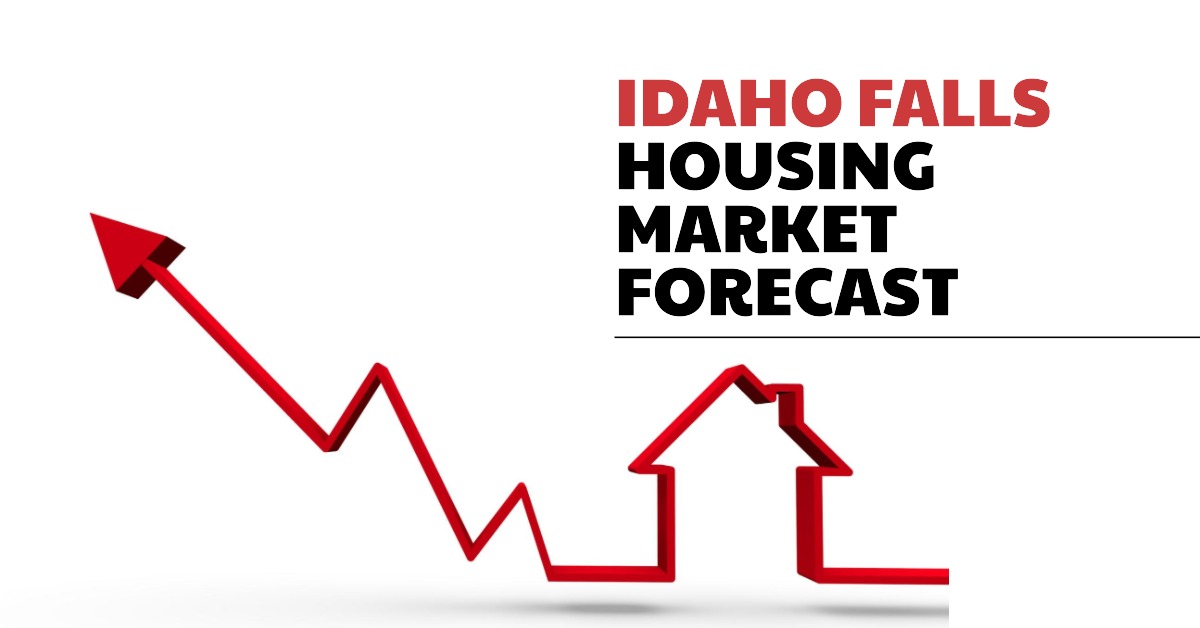If you're wondering about the current Idaho Falls housing market trends, here's the snapshot: As of January 2025, the median sale price of a home in Idaho Falls is $350,000, showing a significant increase of 17.1% compared to last year. While prices have gone up, the number of homes sold has decreased, and homes are staying on the market slightly longer. This suggests a market in transition.
I've been watching the real estate scene in Idaho Falls for a while now, and it's definitely a dynamic place. Let’s break down what's happening and what it means for you, whether you're looking to buy, sell, or just keep an eye on things.
Table of Contents
Current Idaho Falls Housing Market Trends
Home Sales
Let's start with how many homes are actually changing hands.
- According to Redfin, in January 2025, there were 33 homes sold in Idaho Falls.
- This is a decrease of 31.3% compared to the same period last year (January 2024).
Fewer sales could indicate several things. It could be due to rising prices, fewer homes available, or a combination of both. It also might mean people are waiting to see what happens with interest rates before making a move.
Home Prices
Here's where things get interesting.
- The median sale price of a home in Idaho Falls is $350,000 (January 2025).
- That's a 17.1% increase compared to January 2024.
That’s a pretty big jump! It highlights that despite fewer sales, demand is still strong enough to push prices upward. The fact that houses are selling higher year over year is something any prospective seller will be looking for.
Are Home Prices Dropping?
This is the million-dollar question, isn't it? Based on the data, the immediate answer is no, home prices are not dropping in Idaho Falls. They are still on the rise. However, we can't just look at one month's data in isolation. To truly answer this question with certainty, we need to watch the market closely over the next few months. Keep an eye on these factors:
- Inventory levels: Are more homes coming onto the market? If so, that could ease some of the price pressure.
- Mortgage rates: Any significant changes could impact buyer demand.
- Economic conditions: Overall economic health plays a big role in housing market stability.
Comparison with Current National Median Price
Okay, how does Idaho Falls stack up against the rest of the country?
- National Median Price (January 2025): $396,900
- Year-over-Year Change: +4.8%
- Idaho Falls Median Price: $350,000
This means that Idaho Falls homes are currently more affordable than the national average. It's important to point out this price difference. It shows that the housing market in Idaho Falls is still very strong and hasn't stalled out like other cities in the U.S.
Table: Idaho Falls vs. National Housing Market (January 2025)
| Feature | Idaho Falls, ID | National Average |
|---|---|---|
| Median Sale Price | $350,000 | $396,900 |
| Year-over-Year Change | +17.1% | +4.8% |
Housing Supply
The number of homes available for sale is a crucial factor in determining market conditions. Unfortunately, the exact inventory numbers aren't readily available in the data provided. To get a clearer picture, I'd recommend checking local real estate listings sites, contacting a local agent, or keeping an eye on reports from the Eastern Idaho Regional Realtors.
If inventory is low, that will continue to put upward pressure on prices. If it starts to increase, it could signal a shift towards a more balanced market.
Is It a Buyer's or Seller's Housing Market?
This is a tricky question. The data suggests it's leaning towards a seller's market but it's not a cut-and-dry scenario. Here's why:
- Rising prices: This is typically a sign of a seller's market, where demand exceeds supply.
- Decreased sales: This indicates that something is shifting, and it might be getting harder for buyers to close deals.
- Slightly longer time on market: Homes are on the market for an average of 57 days compared to 55 days last year. It shows that demand is waning.
Basically, it is not a true seller's market. Sellers do not have an advantage over buyers at this time.
Market Trends
Let's zoom out and look at the bigger picture. Here are a few key trends I'm seeing in the Idaho Falls area:
- Continued population growth: Idaho is one of the fastest-growing states in the country, and Idaho Falls is feeling that impact. More people moving in means more demand for housing.
- Increased interest from out-of-state buyers: Many people are drawn to Idaho's outdoor recreation opportunities, lower cost of living (compared to some other states), and overall quality of life.
- Limited new construction: While there is some new construction happening, it's not keeping pace with demand, which is contributing to the supply shortage.
Impact of high mortgage rates
Mortgage rates play a huge role in the housing market.
- Current mortgage rates are hovering around 6.7% (as of Early March 2025).
These rates are much higher than what we saw a few years ago, and they are definitely impacting affordability. Higher rates mean buyers have less purchasing power. This could lead to some buyers being priced out of the market, or deciding to wait and see if rates come down. The current mortgage rates are one of the major factors that keep the Idaho Falls housing market in check.
My Take on the Idaho Falls Market
From my perspective, the Idaho Falls housing market is at an interesting point. It's still a desirable place to live, and there's a lot of positive momentum. However, the rising prices and higher mortgage rates are creating some challenges.
In summary, the Idaho Falls housing market in early 2025 is characterized by rising prices, fewer sales, and a slight increase in time on the market. While it's still leaning towards a seller's market, buyers need to be prepared and do their homework. Keep an eye on inventory levels, mortgage rates, and economic conditions to get a better sense of where the market is headed.
Factors Fueling the Idaho Falls Real Estate Market
Before diving into the nitty-gritty, let's understand why the Idaho Falls housing market is generating such buzz:
- Booming Economy: Idaho Falls boasts a robust and diversified economy with major players in healthcare, technology, and manufacturing. This stability attracts a consistent influx of professionals seeking employment and housing opportunities.
- Quality of Life: Surrounded by breathtaking natural beauty, from the majestic Grand Tetons to the cascading waterfalls of the Snake River, Idaho Falls offers an enviable quality of life. Outdoor enthusiasts, families, and retirees are drawn to the region's abundance of recreational activities and peaceful ambiance.
- Affordability Compared to Other Western Cities: While Idaho Falls real estate prices have been on an upward trajectory, they remain relatively affordable compared to major metropolitan areas on the West Coast. This affordability factor, coupled with the attractive lifestyle, makes Idaho Falls a magnet for those seeking value for their housing dollar.
- Population Growth: Idaho consistently ranks among the fastest-growing states in the US, and Idaho Falls is no exception. This steady population influx puts upward pressure on housing demand in Idaho Falls, contributing to the competitive nature of the market.
Idaho Falls Housing Market Forecast: What to Expect
Let's dive into the Idaho Falls Housing Market Forecast and break down what the experts are predicting. The good news is that experts are predicting an increase of 2.1% for the Idaho Falls housing market over the next year.
It’s tough to predict the future with certainty, but we can look at the data and trends to get a good idea of where things are headed. As an expert who closely follows the real estate scene, I will give you my take on it all.
What the Numbers Say: A Closer Look
Let's get down to the nitty-gritty. Zillow, a reliable source for real estate data, has provided some forecasts for the Idaho Falls area. Here's a simplified breakdown of their projections:
Data Source: Zillow Real Estate Market Forecasts
| Region | Feb 2025 (Month-over-Month) | April 2025 (Month-over-Month) | Jan 2025 – Jan 2026 (Year-over-Year) |
|---|---|---|---|
| Idaho Falls, ID | 0.3% | 0.5% | 2.1% |
What does this mean?
- Short-Term Gains: Zillow is predicting that home prices in Idaho Falls will see incremental increases month over month in both February and April of 2025. This suggests a steady, albeit gradual, climb.
- Year-Long Outlook: The more significant figure is the 2.1% increase expected over the year leading up to January 2026. This indicates continued growth in the housing market.
Idaho Falls Compared to the Rest of Idaho
It’s important to see how Idaho Falls stacks up against other cities in Idaho. Here’s a quick comparison of Zillow’s forecasts for some other key areas:
| Region | Feb 2025 (Month-over-Month) | April 2025 (Month-over-Month) | Jan 2025 – Jan 2026 (Year-over-Year) |
|---|---|---|---|
| Boise City, ID | 0.3% | 1.4% | 3% |
| Coeur d'Alene, ID | 0.2% | 0.8% | 3.4% |
| Twin Falls, ID | 0.2% | 0.5% | 2.6% |
| Pocatello, ID | 0.4% | 0.8% | 3.3% |
| Rexburg, ID | 0.2% | 0.1% | 1.9% |
| Lewiston, ID | 0.4% | 0.8% | 2% |
As you can see, Idaho Falls' projected growth is relatively in line with other areas, though some, like Boise and Coeur d'Alene, are expected to see slightly higher increases. However, areas like Rexburg and Lewiston are predicted to have lower growth.
Will Home Prices Drop in Idaho Falls? Is a Crash Coming?
This is the question on everyone's mind! Based on the current data, a significant drop or crash in the Idaho Falls housing market seems unlikely. A 2.1% increase suggests a stable, gradually appreciating market.
Several factors support this:
- Steady Demand: Idaho Falls continues to be a desirable place to live, attracting people with its quality of life and affordable cost of living compared to other states.
- Limited Inventory: Like many areas, Idaho Falls is still dealing with a shortage of available homes. This limited supply helps to keep prices stable and prevents a sharp decline.
Of course, unforeseen economic events could always impact the market, but current indicators point towards continued, albeit moderate, growth.
Looking Ahead: A Possible 2026 Forecast
Predicting beyond a year is always tricky, but here's my educated guess. If the current trends continue, we can expect to see moderate growth in 2026 as well. I think a growth rate between 1.5% and 3% is reasonable, assuming the economy remains stable.
Keep in mind that real estate is local. National trends don't always apply directly to Idaho Falls. Staying informed about local market conditions is key to making smart real estate decisions.
Investing in the Idaho Falls Real Estate Market: A Comprehensive Analysis
1. Population Growth and Trends
Idaho Falls is experiencing steady population growth, a crucial factor for real estate investors. The city's appeal is driving an influx of residents, contributing to increased demand for housing. This trend indicates a potentially lucrative market for investors looking for long-term appreciation and consistent rental demand.
2. Economy and Jobs
- Stability: Idaho Falls boasts a relatively strong economy, providing a stable foundation for real estate investments. Economic stability is essential for property value appreciation and ensures a resilient market even during economic fluctuations.
- Job Market: The presence of a thriving job market further enhances the attractiveness of the real estate market. Job opportunities attract new residents, driving demand for both rental and owned properties.
3. Livability and Other Factors
Investors should consider the overall livability of Idaho Falls, including factors such as quality of schools, healthcare, and community amenities. A city with a high livability index tends to attract more residents, positively influencing the real estate market. Additionally, factors like safety, recreational opportunities, and cultural amenities can contribute to sustained demand for housing.
4. Rental Property Market Size and Growth
- Current Size: Assess the size of the rental property market in Idaho Falls. A substantial market size indicates opportunities for investors to tap into a diverse pool of tenants.
- Growth Trends: Analyze growth trends in the rental property market. A market that is expanding suggests increased rental demand, providing potential for rental income growth and property appreciation.
5. Other Factors Related to Real Estate Investing
Consider additional factors that can impact real estate investing:
- Market Trends: Stay informed about current market trends in Idaho Falls. Understanding shifts in buyer and tenant preferences can guide investment decisions.
- Regulatory Environment: Be aware of local regulations and policies affecting real estate. Changes in zoning laws or property taxes can influence the profitability of investments.
- Infrastructure Development: Assess planned infrastructure developments in the city. Proximity to transportation hubs, schools, and commercial centers can enhance property values.
6. Neighborhoods to Watch in Idaho Falls
- Downtown Idaho Falls: Undergoing revitalization, Downtown offers a vibrant mix of shops, restaurants, cultural attractions, and loft-style apartments.
- Riverwalk Subdivision: Located along the Snake River, this desirable neighborhood features upscale homes, green spaces, and walking paths.
- Sunnyside Subdivision: Known for its family-friendly atmosphere, Sunnyside offers a range of housing options and proximity to schools and parks.
Thus, investing in the Idaho Falls real estate market presents an array of opportunities for savvy investors. The combination of population growth, economic stability, livability factors, a thriving rental market, and consideration of various real estate-related factors positions Idaho Falls as a promising destination for those seeking long-term returns on their real estate investments.
Read More:





